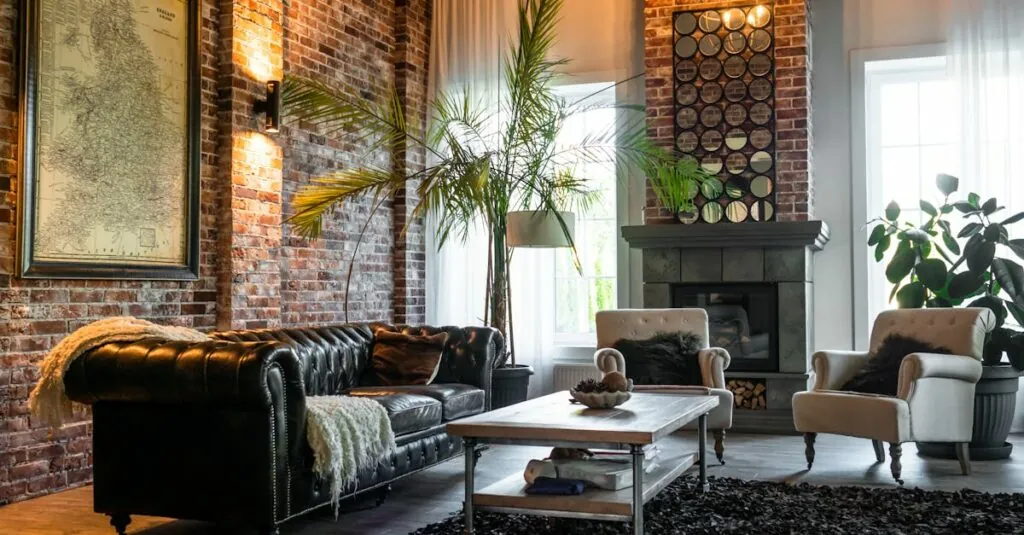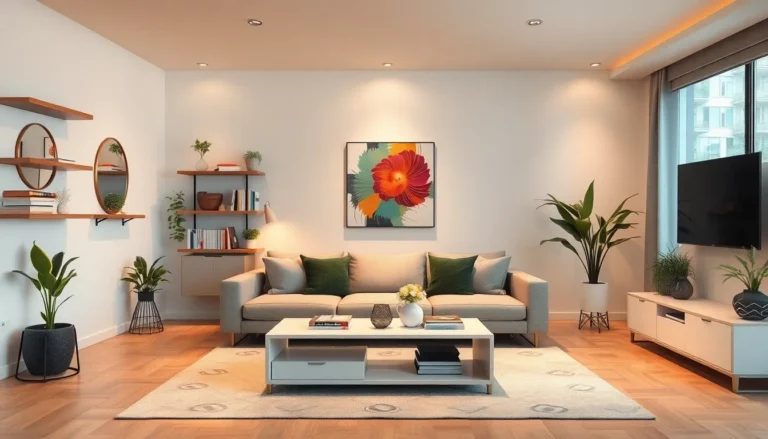Imagine walking into a space that feels like a chic factory—exposed brick, steel beams, and a hint of nostalgia. That’s the magic of industrial interior design. It’s like your favorite coffee shop and a trendy loft had a stylish baby. This design style embraces raw materials and open spaces, creating an atmosphere that’s both edgy and inviting.
Whether you’re transforming a warehouse into a cozy home or sprucing up a small apartment, industrial design offers a unique blend of functionality and flair. It’s perfect for those who appreciate the beauty in imperfection and want their space to tell a story. Get ready to ditch the fluff and embrace the grit; industrial design is here to make your interiors as bold as your coffee.
Table of Contents
ToggleOverview Of Industrial Interior Design Style
Industrial interior design stands out due to its emphasis on raw materials and functional aesthetics. Characterized by large spaces and exposed elements, it often showcases brick walls, steel beams, and wooden floors. This style embraces an urban vibe, drawing inspiration from warehouses and factories.
Accessibility is a key factor, as the design often features open floor plans that enhance fluidity and flexibility. Elements like large windows flood spaces with natural light, creating an inviting atmosphere amidst the rugged style. Decorative accents frequently include vintage furnishings and utilitarian accessories, contributing to a chic yet nostalgic ambiance.
Color palettes lean toward neutral shades, allowing materials to take center stage. Grays, browns, and blacks dominate, frequently complemented by pops of color through furniture or art. Contrast between new and old also plays a significant role, with modern pieces harmonizing alongside reclaimed wood or industrial artifacts.
This design style appeals to individuals who appreciate authenticity and value imperfections. Combining various textures adds depth and character, making spaces feel lived in and personalized. Industry enthusiasts often incorporate unique elements like metal fixtures or quirky light fixtures, enhancing overall visual interest.
Industrial design’s versatility enables it to work in different settings, from loft apartments to commercial spaces. Continuously evolving, this style remains popular due to its unique ability to tell a story through design choices. Individuals drawn to the industrial aesthetic often find it aligns with their desire for originality and creativity in their environments.
Key Characteristics
Industrial interior design is defined by its distinctive features that create a unique ambiance. Key characteristics include raw materials, open spaces, and a neutral color palette.
Raw Materials
Exposed brick, steel beams, and concrete floors highlight the appeal of raw materials in industrial design. These elements convey authenticity and durability. Wood accents often complement these materials, adding warmth and texture. The visual contrast between rough and refined surfaces enhances the overall aesthetic. Metals and glass also play significant roles, creating a rugged yet polished appearance. This emphasis on unrefined substances invites individuality and adds character to spaces.
Open Spaces
Large, unobstructed areas are a hallmark of industrial design. Open spaces promote fluidity and seamless movement throughout a room. These layouts often feature high ceilings, allowing for creative, vertical designs. Natural light floods in from oversized windows, creating an inviting atmosphere. Flexible arrangements facilitate both living and working environments. The connection between spaces enhances social interactions and promotes collaboration. Expansive floor plans offer countless opportunities for personalized furnishings and decor.
Neutral Color Palette
Neutral color palettes dominate industrial interiors, characterized by shades like gray, beige, and white. These muted tones serve as a backdrop for showcasing raw materials. Accents of black or bold colors can add personality while remaining understated. This approach allows existing architectural elements to stand out. Fewer colors contribute to a cohesive and balanced environment. Overall, the neutral palette enhances the overarching rustic vibe while maintaining a modern feel.
Popular Elements
Industrial interior design features several key elements that define its unique and edgy aesthetic.
Exposed Brick and Pipes
Exposed brick walls create a sense of authenticity and warmth in any space. These surfaces serve as natural focal points, drawing attention and adding texture. Additionally, visible pipes and ductwork enhance the industrial vibe, showcasing the building’s structure. These elements complement the overall design while maintaining an unfinished look that many find appealing. Such raw features contribute to the character of the space, reflecting both history and modernity. Incorporating various tones of brick adds depth and interest, allowing for a dynamic interplay of colors.
Vintage Furniture
Vintage furniture plays a crucial role in industrial interiors, offering charm and nostalgia. These pieces, often salvaged from local flea markets or antique shops, carry stories that resonate with the style’s essence. A well-placed vintage chair or table can create a striking contrast against industrial elements. This juxtaposition enhances the room’s character, making it feel more lived-in and inviting. Unique finds, like mid-century sofas or distressed wooden tables, also offer practical seating and functionality. Mixing and matching different styles fosters an eclectic feel that defines the industrial aesthetic.
Statement Lighting
Statement lighting serves as a defining feature in industrial design, providing both function and flair. Pendant lights, especially those with an industrial finish, draw the eye and can become conversation starters. Various fixtures, like oversized bulbs or wrought iron chandeliers, create focal points in open spaces. These lighting choices enhance the ambiance while showcasing the raw materials often found in the architecture. Combining different styles of lighting fixtures can further highlight unique elements in the room. Ultimately, the right statement lighting enhances the overall character of industrial interiors, making them inviting and stylish.
Benefits Of Industrial Interior Design Style
Industrial interior design style offers several compelling advantages that appeal to various preferences. First, it promotes an open and airy feel, thanks to large floor plans. Spacious layouts encourage social interaction while enhancing fluid movement throughout areas.
Next, the use of raw materials such as exposed brick, steel, and concrete elevates the aesthetic value, imparting a sense of authenticity and durability. This robust character withstands the test of time, making it both stylish and practical.
Another significant benefit involves its aesthetic versatility. Industrial design can seamlessly adapt to different environments, from chic urban lofts to creative office spaces. Design elements can easily blend with other styles, offering individuals the freedom to express their unique tastes.
Moreover, this style embraces imperfections, celebrating the beauty in the unfinished and rustic. This emphasis contributes to a visually rich atmosphere, where unique textures and vintage furnishings add depth.
Energy-efficient lighting fixtures, like pendant lights, serve as functional and artistic elements. These fixtures often become conversation starters, enhancing the overall appeal of the space.
Additionally, the neutral color palette allows for creative freedom in decorating while maintaining a cohesive look. This simplicity ensures that each featured element, whether raw materials or decor, stands out effectively.
Finally, embracing large windows floods interiors with natural light, enhancing ambiance and mood. This feature not only makes spaces feel larger but also creates a welcoming environment. Industrial interior design style stands out for its ability to combine practicality with striking aesthetics, resulting in a captivating appeal.
How To Incorporate Industrial Style In Your Home
Incorporating industrial style into one’s home involves thoughtful selection of furniture, color schemes, and accessories.
Choosing The Right Furniture
Select furniture that complements the industrial aesthetic. Pieces made from reclaimed wood and metal embody the style’s raw texture. Prioritize functional designs over ornate styles, opting for simple tables and chairs with clean lines. Consider utilizing vintage finds, which enhance the character of the space. Incorporate bold statement pieces, such as a metal coffee table or leather sofa, to create focal points. Seek out functional furniture that adds versatility and fits within open layouts.
Selecting Color Schemes
Employ a neutral color palette to embody the industrial design ethos. Shades like gray, beige, and white provide a perfect backdrop for raw materials. Use these tones liberally on walls and large furniture items, allowing other elements to stand out. Additionally, accentuate with darker hues such as charcoals and browns for depth and sophistication. Consider adding pops of color through accessories and artwork to maintain a vibrant yet balanced atmosphere. Base the color choices on the space’s natural light, which influences how colors are perceived.
Accessorizing With Industrial Decor
Choose accessories that reflect the industrial style’s unique charm. Incorporate decorative items made from metal and glass, enhancing the raw and rugged feel. Vintage signage and metal wall art can serve as interesting focal points. Consider using exposed light bulbs in fixtures to add an authentic touch. Utilize utilitarian accessories, such as old crates or metal baskets, for practical storage solutions. Layer textures by combining elements like leather, wood, and metal, which creates visual interest and depth.
Industrial interior design stands out for its unique blend of raw materials and functional aesthetics. This style not only embraces imperfections but also tells a story through its elements. With its versatility and urban charm it appeals to those seeking authenticity in their spaces.
By incorporating vintage furnishings and statement lighting individuals can create an inviting atmosphere that balances modernity with nostalgia. The emphasis on open spaces and natural light fosters a welcoming environment perfect for both social interactions and personal retreats.
Ultimately industrial design offers a captivating aesthetic that encourages creativity and originality making it a timeless choice for various settings.








